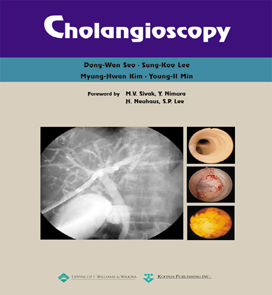Cholangioscopy
Chapter Ⅰ. Introduction
1. History of Cholangioscopy
2. Instruments
1) Cholangioscope
2) Accessory equipment
Chapter Ⅱ. Techniques of Cholangioscopy
1. Peroral Cholangioscopy
2. Percutaneous Transhepatic Cholangioscopy
1) Percutaneous transhepatic biliary drainage
2) Tract dilatation
3) Percutaneous transhepatic cholangioscopy examination
3. Postoperative Cholangioscopy
4. Percutaneous Cholecystoscopy
5. Cholangioscopic Cholangiography
6. Chromocholangioscopy
7. Cholangioscopic Biopsy
Chapter Ⅲ. Normal Biliary Tree
1. Normal Variation of the Biliary Tree
2. The Sinus Tract
3. The Extrahepatic Bile Duct
4. The Intrahepatic Bile Ducts
5. The Supra-Ampullary and Ampullary Area
6. The Gallbladder
Chapter Ⅳ. Bengin Lesions of Bile Ducts and Gallbladder
1. Stone Disease in the Biliary Tree
2. Benign Stricture of the Biliary Tree
3. Postinflammatory Mucosal Changes
4. Parasites
1) Clonorchis sinensis
2) Fasciola heparica
3) Biliary ascariasis
5. Cholesterolosis
6. Submucosal Tumor
Chapter Ⅴ. Neoplasms of the Biliary tree
1. Bile Duct Adenoma
2. Bile Duct Adenocarcinoma
1) Nodular-type adenocarcinoma
2) Papillary-type adenocarcinoma
3) Infiltrative-type adenocarcinoma
3. Biliary Papillomatosis
4. Mucin Hypersecreting Bile Duct Cancer
5. Biliary Cystadenocarcinoma
6. Heparocellular Carcinoma Invading the Bile Duct
7. Gallbladder Carcinoma
8. Extrabiliary Carcinoma Invading the Bile Duct
9. Usefulness of Cholangioscopy in Bile Duct Tumors
Chapter Ⅵ. Iatrogenic lesions of the biliary Tree
1. Bile Duct Changes Associated with Catheters
2. Bile Duct Rupture and Exposure of Hepatic parenchyma
3. Ductal Injury Caused by Electrohydraulic Lithotripsy
4. Foreign Bodies
Chapter Ⅶ. Cholangioscopic Interventions
1. Stone Removal
1) Basic techniques for cholangioscopic stone removal
(1) Basket selection
(2) Basket stone removal
(3) Stone fragmentation
(4) Irrigation method
(5) The cholangioscopic push method
(6) Stricture dilatation
2) Advanced techniques to solve difficult problems
(1) Difficult angles
(2) Missing ducts and stones
(3) Selection of the best therapeutic strategy
(4) Results of cholangioscopic stone removal
2. Percutaneous Stent Insertion
3. Percutaneous Transductal Manometry of the Sphincter of Oddi
4. Cholangioscope-Guided Intraductal Tumor Ablation
Chapter Ⅷ. Complications of Cholangioscopy
1. Pain
2. Cholangitis and Sepsis
3. Bleeding
4. Local Wound Infection and Subcutaneous Nodule
5. Bile Leakage
6. Other Complications
Index
Appendix A: referral organizations
Glossary
Index


